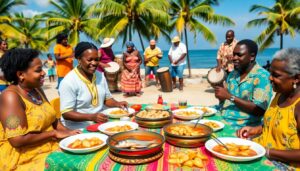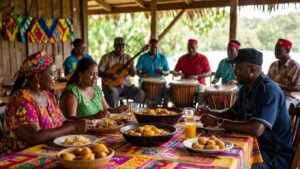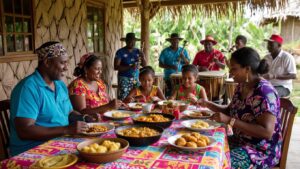Exploring the Rich Tapestry of Garifuna Culture in Belize: A Deep Dive into Heritage, Culinary Delights, and Interactive Experiences
The Garifuna community in Belize showcases a vibrant fusion of African, Indigenous Caribbean, and European cultural influences, leading to a unique cultural legacy that has earned global admiration and recognition from UNESCO. Their extensive traditions encompass various aspects such as language, music, culinary arts, dance, spirituality, and a strong sense of community. This comprehensive guide encourages you to delve into the captivating narrative of the Garifuna in Belize, highlighting their history, traditions, festivals, and the lively cultural centre of Hopkins Village.
Discovering the Rich Heritage of the Garifuna People
The Garifuna stand as one of the most remarkable cultural groups in Belize, with ancestral roots tracing back to both West and Central African origins, along with the Indigenous Caribs and Arawaks. Their journey began with a courageous resistance against colonial oppression in St. Vincent in 1797, which ultimately resulted in their forced relocation to Central America. Presently, around 30,000 Garifuna individuals inhabit Belize, contributing significantly to the cultural richness of southern Belize through their distinctive language, mouth-watering cuisine, vibrant art, and treasured customs. Recognised by UNESCO as a Masterpiece of the Oral and Intangible Heritage of Humanity, their resilient spirit, creativity, and adaptability continue to flourish in communities such as Dangriga, Hopkins, Seine Bight, and Punta Gorda, alongside diaspora communities throughout the Americas. The annual observance of Garifuna Settlement Day on November 19th serves as a powerful symbol of their history of resilience, community, and rich cultural traditions.

Uncovering the Historical Foundations of the Garifuna Community
Following the Ancestry of African and Carib Heritage
The narrative of the Garifuna people is rooted in the 17th century, marking an extraordinary convergence of African survivors from two Spanish slave ships and the Indigenous Carib and Arawak populations of St. Vincent in the Lesser Antilles. Over a span of more than 150 years, intermarriage and cultural interactions led to the emergence of a unique Afro-Indigenous identity known as Garinagu. This identity encompasses a rich array of traditions, languages, and practices that vividly illustrate their diverse ancestral heritage, celebrating the beauty and depth of their cultural lineage.
Forced Displacement and New Beginnings in Belize
In 1797, following fierce resistance against British colonial forces, approximately 5,000 Garifuna were forcibly removed from St. Vincent to Roatán, Honduras. This pivotal event initiated a series of migrations along the Central American coastline. By the early 19th century, vibrant Garifuna communities had emerged in southern Belize, especially in culturally prominent areas like Dangriga, often regarded as the cultural capital, alongside Hopkins, Seine Bight, and Barranco. British authorities encouraged these migrations, seeking skilled labourers proficient in fishing and agriculture, which catalysed the development of these communities.
Perseverance in the Face of Adversity and Cultural Continuity
Despite enduring numerous challenges brought about by European colonisation, land dispossession, and systemic discrimination, the Garifuna have remarkably preserved their language, social structures, and vibrant religious traditions. The establishment of the National Garifuna Council in 1981 has played a crucial role in advocating for cultural rights and educational initiatives, ensuring that the Garifuna heritage is celebrated and acknowledged throughout Belize and beyond.
The Essence of Language and Identity in Garifuna Culture
The Unique Characteristics of the Garifuna Language
The Garifuna language represents a unique Arawakan tongue, characterised by its incorporation of Carib and African loanwords, which makes it a remarkable example among Central American languages. It includes gendered pronouns, a complex tense system, and a rich array of oral traditions that convey the community's history and cultural values. However, the survival of the Garifuna language is currently at risk due to a language shift driven by migration and urbanisation, with fewer than 15,000 Belizean Garifuna individuals remaining fully fluent, highlighting the urgent need for revitalisation efforts to safeguard this precious linguistic heritage.
Initiatives for Revitalising and Preserving Linguistic Heritage
The recognition of the Garifuna language and music as an Intangible Heritage by UNESCO in 2001 has spurred various revitalisation initiatives. In communities such as Hopkins and Dangriga, primary schools now offer educational programmes in Garifuna, while community radio stations broadcast music and news in the language, promoting its continuity. Organisations like GAMAE International have initiated language immersion summer camps designed to reconnect youth with their ancestral roots and linguistic heritage, ensuring the transmission of culture across generations. These efforts are vital for fostering a deeper appreciation of their unique identity.
Expressions of Cultural Identity and Global Diaspora Connections
Garifuna identity is reinforced through traditional clothing, ancestral lineages, clan totems, and distinctive naming customs. This identity is actively nurtured by cultural associations both within Belize and in diaspora communities located in major cities such as New York, Los Angeles, and London, where members persist in celebrating their rich heritage and cultural legacy. These connections serve to strengthen community bonds and ensure that the Garifuna culture continues to thrive, even far from its geographical roots.
The Vibrant World of Garifuna Music and Dance
The Spiritual Significance of Rhythmic Drumming
Garifuna music is celebrated for its intricate rhythmic patterns, seamlessly merging traditional African polyrhythms with indigenous chants. Central to numerous spiritual rituals and celebratory events, the drums—specifically the primero (tenor) and segunda (bass)—play a crucial role in expressing cultural identity. The sacred dugú ceremony, for instance, incorporates drum circles and ancestral invocations designed to heal or bless families, exemplifying the profound connection between music and spirituality that permeates Garifuna culture.
Exploring the Dynamic Dance Forms of Punta and Punta Rock
One of the most celebrated Garifuna dance styles is the punta, characterised by rapid hip movements and intricate footwork, often accompanied by call-and-response singing and vibrant percussion. The contemporary evolution of this dance form, known as punta rock, has gained popularity through renowned musicians such as Andy Palacio and Pen Cayetano, who blend traditional rhythms with modern instrumentation, thus helping to spread Garifuna culture to audiences around the globe. This dynamic fusion keeps the cultural expression alive and relevant.
Cultural Festivals and Community Engagement in Dance
In the bustling towns of Hopkins and Dangriga, dance troupes frequently perform during cultural festivals and for visiting tourists, creating a vibrant bridge between generations. These performances not only honour Garifuna heritage but also serve as a vital economic resource for the community, boosting tourism and cultural exchange while enriching the local economy. By showcasing their artistic talents, the Garifuna people invite others to appreciate their culture and traditions.

Delving into Garifuna Cultural Practices and Spiritual Beliefs
The Significance of the Dugú Ceremony
The dugú ceremony is a multi-day event wherein extended families gather to honour the spirits of their ancestors, known as gubida. Led by a spiritual healer, or buyei, the ceremony encompasses music, dance, and communal feasting, all aimed at restoring harmony within families and the broader community. It highlights a profound respect for the land, ancestral heritage, and shared responsibilities among community members, reinforcing their cultural values.
Everyday Spiritual Practices and Cultural Life of the Garifuna
The spiritual beliefs of the Garifuna embody a unique blend of Catholicism interwoven with elements from African and Arawak cosmologies. Daily life is enriched with various rituals, which include blessings for new structures, rites of passage for births and deaths, and agricultural celebrations. Important symbols, such as the conch shell, sea turtle, and cassava, serve as vital links between households, the natural environment, and ancestral spirits, weaving a rich tapestry of meaning into their everyday experiences and interactions.
Sampling the Culinary Delights of Garifuna Gastronomy
Signature Dishes and Culinary Staples of Garifuna Cuisine
The culinary craftsmanship of Garifuna culture is deeply rooted in staples such as cassava (also known as yuca), plantains, coconut, and fresh seafood. Among their traditional offerings, ereba stands out as a cassava bread crafted from grated cassava that is pressed and toasted over an open flame. Another signature dish, hudut, features fish simmered in creamy coconut milk, served alongside mashed green and ripe plantains. Machuca, a hearty fish soup with garlicky, mashed plantain dumplings, and tapou, a savoury coconut milk seafood stew, are also beloved staples. In lively street markets in Hopkins and Dangriga, visitors are encouraged to indulge in local delicacies such as cassava pone (a sweet cake), fried plantain balls (known as ganún), and refreshing conch ceviche, showcasing the vibrant flavours of Garifuna cuisine.
Encouraging Sustainable Culinary Practices within the Community
Traditional Garifuna culinary methods, including seasonal fishing, shellfish gathering, and small-scale gardening, promote ecological stewardship and sustainability. These practices are guided by cultural taboos and communal resource management principles, reflecting their deep connection to the environment. Culinary festivals hosted in Hopkins feature cooking competitions and food tours organised by women’s cooperatives, ensuring the preservation of cherished recipes and culinary techniques while engaging visitors in the rich gastronomic heritage of the Garifuna. Such events not only celebrate their culinary arts but also foster community cohesion.
Hopkins Village: The Heart and Soul of Garifuna Culture
Historical Context and Cultural Importance of Hopkins Village
Founded in the early 1800s and known as Yarumein in Garifuna, Hopkins is located along the picturesque Stann Creek coast. It serves as a vital hub for the Garifuna language, music, and crafts, embodying the rich cultural legacy of this community and acting as a beacon for cultural preservation. The village's atmosphere is a vibrant reflection of Garifuna cultural practices, inviting visitors to immerse themselves in its rich traditions.
Essential Cultural Experiences to Explore in Hopkins
- Drum Circles: Participate in daily drum schools and enjoy nightly drum circles at local cultural centres, embracing the rhythmic heartbeat of Garifuna traditions.
- Garifuna Museum: Discover artefacts, oral histories, and photographic archives that delve into their migration, language, and music, offering insights into their rich cultural narrative.
- Homestays and Workshops: Connect with local families who provide cooking lessons, fishing trips, and demonstrations of cassava bread preparation, creating authentic cultural exchanges.
Annual cultural events in Hopkins, particularly the youth pageants during Garifuna Settlement Day, establish the village as an authentic gateway to experiencing the intricate cultural tapestry of Garifuna Belize. These events are not just celebrations; they are also opportunities for education and cultural exchange.
The Economic Benefits of Cultural Tourism for the Community
Cultural tourism plays a crucial role in the economy of Hopkins, supporting over 75% of local households through guest accommodations, handicrafts, music classes, and guided tours. The headquarters of the National Garifuna Council coordinates regional festivals and advocacy initiatives, ensuring that Garifuna culture remains vibrant and prominent on the global stage. By welcoming visitors, the community can share its rich heritage while fostering economic growth and sustainability.
Celebrating Garifuna Settlement Day: A Cultural Commemoration
The Historical Significance of Settlement Day
Celebrated each November 19 since 1941 and nationally recognised since 1977, Garifuna Settlement Day commemorates the historic arrival of Garifuna ancestors in Belize by canoe in 1802. The reenactment procession known as Yurumein sees villagers arriving ashore, carrying drums, cassava, and crops, accompanied by jubilant singing and prayers. This event symbolises their enduring legacy and connection to their cultural roots, reinforcing the importance of their heritage.
Modern Celebrations and Festivities Surrounding Settlement Day
The festivities of Garifuna Settlement Day beautifully intertwine sacred and secular elements, featuring all-night dugú ceremonies and all-day drumming in churches and community squares. Processions adorned in traditional attire, lively parades, dance performances, and food fairs enhance the day's significance. National broadcasts, media coverage, and diaspora celebrations in major US cities attract visitors from across Belize and beyond, fostering greater awareness and appreciation for Garifuna cultural traditions. This vibrant celebration serves as a reminder of the resilience and richness of Garifuna culture.
Addressing Modern Challenges and Sustaining Cultural Heritage
The Pressing Issue of Language Shift Among Younger Generations
The phenomenon of language shift poses a significant challenge for the Garifuna community, as many young individuals, particularly in urban settings, increasingly prefer English or Kriol at home. Recognising this concerning trend, UNESCO has encouraged schools and NGOs to implement language immersion programmes, radio broadcasts, and mentorship initiatives aimed at preserving linguistic heritage and cultural identity. These efforts are critical to ensuring the survival of the Garifuna language and its associated cultural practices.
Land Rights and Tourism Development Challenges
The rapid expansion of tourism and real estate development in coastal areas such as Seine Bight and Hopkins threatens the traditional landholdings of the Garifuna. Advocacy efforts by the National Garifuna Council and collaborative NGOs focus on securing land rights, influencing urban planning, and ensuring that tourism revenues are equitably shared among local families and communities. Such initiatives are essential for safeguarding their cultural heritage and ensuring their voices are heard in development discussions.
Engaging Youth Through Arts, Technology, and Global Connections
Garifuna artists and musicians, both locally and within the diaspora, are actively recording music, documenting recipes, and preserving oral histories to create digital archives and virtual festivals. These innovative platforms are vital for fostering connections between the broader Garifuna community and younger generations, ensuring that their rich cultural heritage is upheld and celebrated. By leveraging modern technology, they can engage the youth in meaningful ways, encouraging a deeper appreciation for their cultural identity.
Guidelines for Respectful Engagement with Garifuna Culture
- Choose accommodations in Hopkins, Dangriga, or Seine Bight, and arrange tours directly with Garifuna-owned businesses to support the local economy.
- Participate in a drum workshop, attend a Settlement Day celebration, or volunteer in local cultural preservation efforts to immerse yourself in the rich cultural tapestry of the Garifuna.
- Support women’s cooperatives by sampling traditional dishes or purchasing handcrafted items to promote sustainable livelihoods and economic empowerment.
- Always respect local customs; seek permission before photographing individuals, and be mindful during rituals and ceremonies to honour their traditions.
- Learn a few basic words in the Garifuna language to demonstrate your respect and genuine interest in the culture, fostering a deeper connection with the community.
The Garifuna culture in Belize encapsulates a vibrant tapestry of resilience, spirituality, infectious music, exquisite culinary offerings, and robust community ties. By visiting locations like Hopkins or Dangriga, participating in local festivals, or immersing oneself in the rhythmic heartbeat of the drums, travellers are granted a unique opportunity to engage with a rich historical continuum where the past and present resonate harmoniously. Supporting businesses owned by the Garifuna, honouring their traditions, and celebrating the linguistic and culinary diversity of this remarkable culture are essential steps to ensure its survival and flourishing for future generations.
References and Additional Resources for Cultural Enthusiasts
- Language, Dance and Music of the Garifuna – UNESCO Intangible Heritage
- History Of The Garifuna People – Belize.com
- Garifuna people – Wikipedia
- Varner, G.R. “Native Status and Maya Identity in Belize.” Journal of Latin American Anthropology, 1998
- Lee, N.R. “Toledo Garifuna and Indigenous Rights.” Mesoamerican Research, 2022
- National Garifuna Council – Wikipedia
- The Garifuna Living Heritage – ICH NGO Forum, 2023
- Dinther, R. “Language Shift and Prestige: Garifuna in Hopkins.” Journal of Pidgin and Creole Languages, 2017
- Habinaha Garifuna Language Program
- Veal, T. “Africanisms in Garifuna Culture of Belize.” Cultural Anthropology, 2004
- National Geographic: Preserving Garifuna Identity Through Ritual
- Music In Africa: Punta Rock and Garifuna Music
- Hopkins Cultural Center Official Site
- Cultural Survival Quarterly: Maya Rainforest and Garifuna in Belize
- Belize Living Heritage: Rituals and Social Practices
- Texas A&M: Belizean Food Culture
- Love Your Belize: Hudut Recipe
- Global M&A Pages: Sustainable Fishing Cooperatives
- National Garifuna Council of Belize
- UN Sustainable Development Reports on Garifuna Cultural Tourism
- Ambergris Caye: Garifuna Settlement Day Celebrations
- Garifuna.com: Diaspora, Digital Storytelling, and Modern Initiatives
This article Garifuna Culture in Belize: Heritage, Food & Where to Experience It first appeared on Belize Travel Guide
This article Garifuna Culture: Experience Heritage and Cuisine in Belize was found on https://limitsofstrategy.com
This article Garifuna Culture: Discover Belize’s Heritage and Cuisine first appeared on https://electroquench.com


